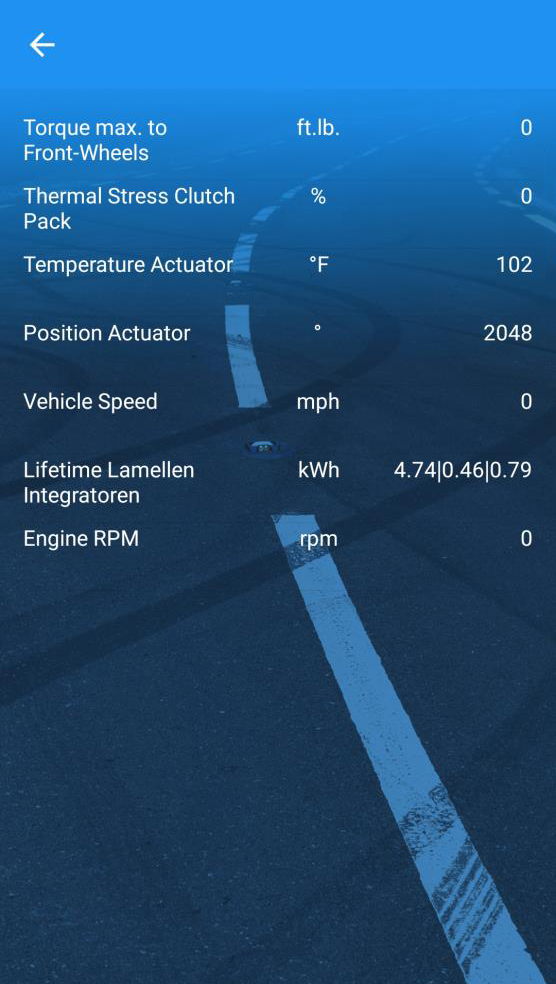| Table of Contents |
|---|
To
access the Live Data
screen, click on your car on the main page and click on the
three white dots
at the top
right of the
screen. From the Misc.
menu, select "Live Data" while connected to your car.
xDelete will now continuously
read important performance information from your transfer case, including the following:
Torque Max. to Front Wheels
Thermal Stress Clutch Pack
Temperature Actuator
Status colour Green title E-series only Position Actuator:
Vehicle Speed
Status colour Green title E-series only Lifetime Workload Clutch pack L1/L2/L3
Engine RPM
Status colour Green title E-series only
.
Torque Max. to Front Wheels
Shows you the actual clutch pressure, converted to the max. transferable torqueOil-Wear (G-Series)
The xDrive system consists of a wet clutch and an electric actuator that opens and closes the clutch to transfer power to the front wheels. The clutch is immersed in oil, which keeps wear to a minimum, but it does wear over time. This measurement is the calculated load that the current oil has already received and can be used as an additional indication of when the oil service is due. The recommended oil change interval for the xDrive system is 150,000 km (~ 93,000 miles). We are collecting statistical data and will publish oil service recommendations at a later date.
Work Chain (G-Series)
The transfer case transmits power to the front wheels via a chain. This is the amount of work the chain has already done. There is no service interval for the chain.
Work Clutch (G-Series)
That's the total amount of work the transfer case clutch has done in its lifetime. We are collecting statistical data and will in the future publish threshold values that indicate a certain level of wear.
Torque to Front Wheels (E,F,G-Series)
Shows the actual clutch pressure converted to the maximum torque that can be transmitted to the front wheels. This is NOT the actual torque transmitted, this is but the max. maximum torque the clutch can forward at a given pressure.
Thermal Stress Clutch Packtransmit with the current pressure applied.
Temperature Clutch (G-Series)
The calculated temperature inside the clutch pack. This value rises rapidly during slippage and high loads. When a certain threshold is reached, the xDrive system temporarily shuts down until the value has returned to a safe range.
Clutch Stress (E,F,G-Series)
As soon as there is a relative movement between the Front and Rear wheels, slip occurs within the clutch pack. This slip is converted into heat and wear. The xDrive ECU calculates the resulting clutch- temperatures and converts this into a maximum percentage of the permissible temperature. As a rule of thumb, you should not exceed 50% thermal load for extended periods.
When relative movement between the front and rear wheels occurs, slip occurs within the clutch pack. This slip is converted into heat and wear. The xDrive ECU calculates the resulting clutch temperatures and converts them into a maximum percentage of the permissible temperature. As a rule of thumb, the thermal load should not exceed 50% for long periods.
| Status | ||||
|---|---|---|---|---|
|
| Status | ||||
|---|---|---|---|---|
|
Normal (0-50% Stress)
Level 1 (51% - 80% Stress)
Level 2 (81% - 100% Stress)
| Info |
|---|
The App app screen will flash yellow and red, when reaching Level levels 1 and 2 are reached. |
Temperature actuator (E-Series)
The spindle driven by the actuator is submerged immersed in oil and is an indicator for the oil , indicating the temperature. Temperature
The temperature should not exceed 90° C. 90°C (~ 195 °F).
| Status | ||||
|---|---|---|---|---|
|
| Status | ||||
|---|---|---|---|---|
|
Normal (0-30% Stress)
Level 1 (31% - 50% Stress)
Level 2 (51% - 80% Stress)
Level 3 (80% - 100% Stress)
| Info |
|---|
The App app screen will flash yellow,orange and red, when reaching Level 1-3levels 1, 2 and 3 are reached. |
Lifetime Workload Clutch pack L1/L2/L3
Those(E, F, G-Series)
These are the lifetime slip-workload counters of for your transfer case clutch pack. The higher the workload, the higher the wear in /slip on your clutch pack. The counters are split in 3 divided into three classes, which are counted independently:
L1 (left one) is the lowest power -class level and is usually the one where the most workload happens in. This is slip wear occurs. These slips and wear occur during normal drivingeveryday riding, turning at junctions, etc. (Power power class 0-200 Wattswatts).
L2 (200 to 2000 Wattswatts) and L3 (> 2000 Wattswatts) are the high ones, which get upped are increased when the Thermal Stress thermal load on the Clutch clutch is already raisedhigh.
If the L3 value being is high, is an indication for this indicates heavy use in the past. The complete total workload is calculated by summing up all 3 three counters.
Those counters do not get reset with an oil-service, An oil service does not reset these counters as they reflect clutch - pack wear, not oil - deterioration.
A single clutch pack is good for around 100 kWh of total workload on E-Series series cars and 50 kWh on F-series cars. For G-Series cars we are still collecting data and will release guidelines at a later stage.
| Info |
|---|
The app will highlight the counters in yellow or red as they approach their respective limits. |
Angle Actual (E,F,G-Series)
This is the actual angle of the stepper motor inside the transfer case. The greater the angle, the harder the clutch is pressed and the more torque can be transferred. This value changes constantly during operation and is based on many vehicle dynamic factors such as engine torque, current gear, cornering angle/steering wheel angle, vehicle slip, wheel slip etc.
Back to the Overview Page.
